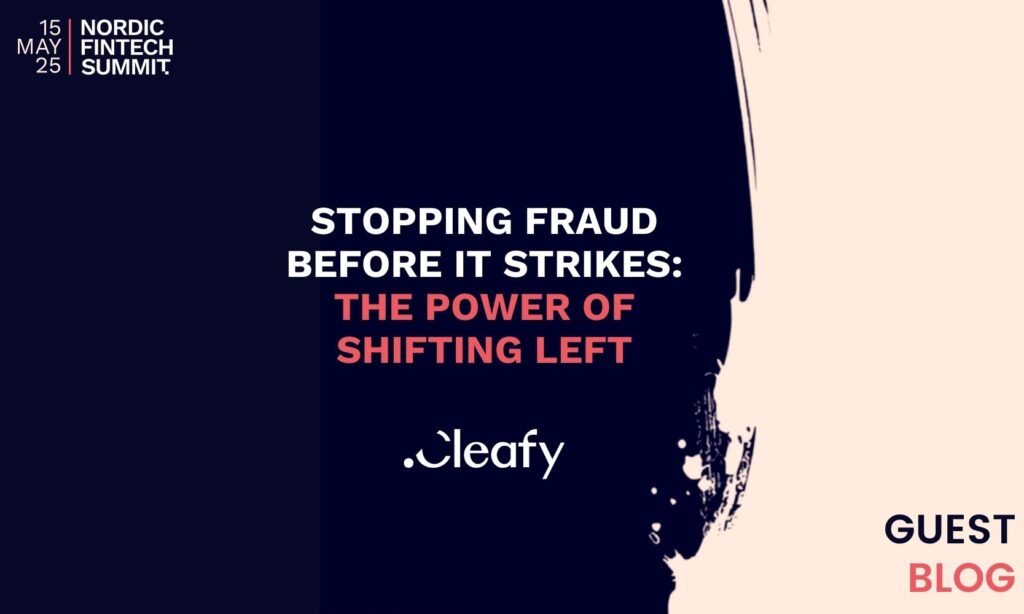On May 15, 2025, Cleafy will sponsor the Nordic Fintech Summit taking place in Helsinki.
The financial sector is in a relentless battle against payment fraud. As digital transactions grow, so do the tactics of cybercriminals. According to Paystand, global payment fraud is expected to reach $40 billion by 2027, with fraudsters exploiting vulnerabilities across online banking, mobile payments, and real-time transactions.
Traditional fraud prevention methods often detect fraud only when money moves, flagging suspicious activity after the fact. This reactive approach is no longer sufficient. The ecosystem needs a shift, a proactive strategy that stops fraud before a transaction is completed. Enter the concept of “shifting left” in cybersecurity.
Why cyber is the next line of defence
Cybersecurity is no longer just about defending network perimeters; it’s about safeguarding financial transactions from the outset. Fraud isn’t just a financial issue; it’s a security threat that exposes weaknesses in real-time payment systems, making a cybersecurity-driven approach essential. Cyber-enabled fraud detection integrates threat intelligence, behavioural analytics, and AI-driven anomaly detection to identify suspicious activity before money moves. By leveraging real-time monitoring of digital interactions, financial institutions can spot fraudulent intent early.
Fraudsters increasingly use stolen credentials, social engineering, and malware to bypass authentication systems. Traditional fraud prevention tools, like rule-based systems, struggle to keep up with these sophisticated attacks. On the other hand, cybersecurity-driven solutions analyse digital footprints, device behaviour, and login patterns to detect and prevent fraud before it happens.
In a recent interview, Mick Morris, Product Director at Cleafy, said: “A proactive cyber-fraud approach is paramount in the battle against fraud. Relying solely on traditional, reactive measures is no longer sufficient. By embracing FxDR, banks can detect and prevent fraudulent activities before they impact customers, safeguarding their assets and reputation.”
To stay ahead, technical leaders must integrate fraud prevention as a fundamental part of their security infrastructure. This means deploying solutions that not only detect threats accurately but also integrate seamlessly into existing technology environments without adding complexity or compromising performance. The future of fraud prevention lies in predictive and proactive capabilities, ensuring security measures move as fast as the threats they counter.
The cyber-fraud approach for banking: how it works
A cyber-fraud approach integrates cybersecurity tools with fraud prevention strategies, creating a seamless defence mechanism. Here’s how it works:
- Early threat detection – Financial institutions use machine learning and artificial intelligence to analyse customer behaviour and detect anomalies. Suspicious login attempts, unusual spending patterns, or rapid-fire transactions trigger early warnings.
- Real-time risk assessment – Risk scoring models assess each transaction based on multiple factors, including user behaviour, location, device, and historical data. If a transaction appears risky, additional authentication steps are triggered before approval.
- Behavioural biometrics and AI – Behavioral biometrics, such as keystroke dynamics and mouse movements, help differentiate between legitimate users and fraudsters. AI-driven solutions can identify fraud attempts based on micro-patterns that human analysts might miss.
- Shared intelligence – Banks, payment processors, and cybersecurity firms must collaborate to share threat intelligence. This approach strengthens the entire financial ecosystem against cyber-enabled fraud.
Rethinking fraud prevention with Extended Detection and Response
A key component in the “shifting-left” approach is FxDR (Fraud Detection and Response), an emerging framework that enhances real-time fraud mitigation by combining cybersecurity and fraud management.
Unlike traditional fraud prevention measures that often work in isolation, responding to individual threats without considering the bigger picture, FxDR acts as an advanced navigation system, analysing data from multiple sources to uncover intricate fraud patterns. By incorporating insights from network traffic, user behaviour, and transaction history, it offers a holistic view of emerging threats.
This comprehensive approach is crucial because the outdated notion that fraud prevention and cybersecurity should operate separately can lead to gaps in early detection.
By providing financial institutions with a unified, intelligence-driven strategy, FxDR strengthens their ability to preempt fraudulent activities. This ensures smoother and more secure digital transactions while mitigating financial losses before they occur.
Moving forward: It’s time to take action
The “shifting-left” approach to fraud prevention is no longer optional, it is essential. Financial institutions must embrace cybersecurity-driven fraud prevention to stay ahead of evolving threats. By stopping fraud before the transaction, and before authentication, banks can reduce losses, enhance customer trust, and fortify the digital economy.
The future of payments depends on security-first innovation. Is your organisation ready to take the leap? Contact us to learn how Cleafy can help level up your fraud defence.
Cleafy
We’re more than a tech company – we’re a team of cybersecurity pioneers. Founded by alumni of the Polytechnic of Milan, Cleafy was built to outpace fraud by thinking differently. Our roots are in the real-world challenges banks face every day. From protecting institutions against digital threats to anticipating what comes next, we’ve turned hard-earned experience into actionable solutions.
We’ve stood shoulder to shoulder with financial leaders through their toughest moments, proving that preparation beats reaction. Fraudsters don’t wait, and neither do we.
Recognized as a market leader by industry analysts, today Cleafy protects over 100M+ users of top-tier retail and corporate banks worldwide against financial online fraud.
Want to hear more? Join us on May 15th in Helsinki to explore the next chapter in banking, insurance and finance!



